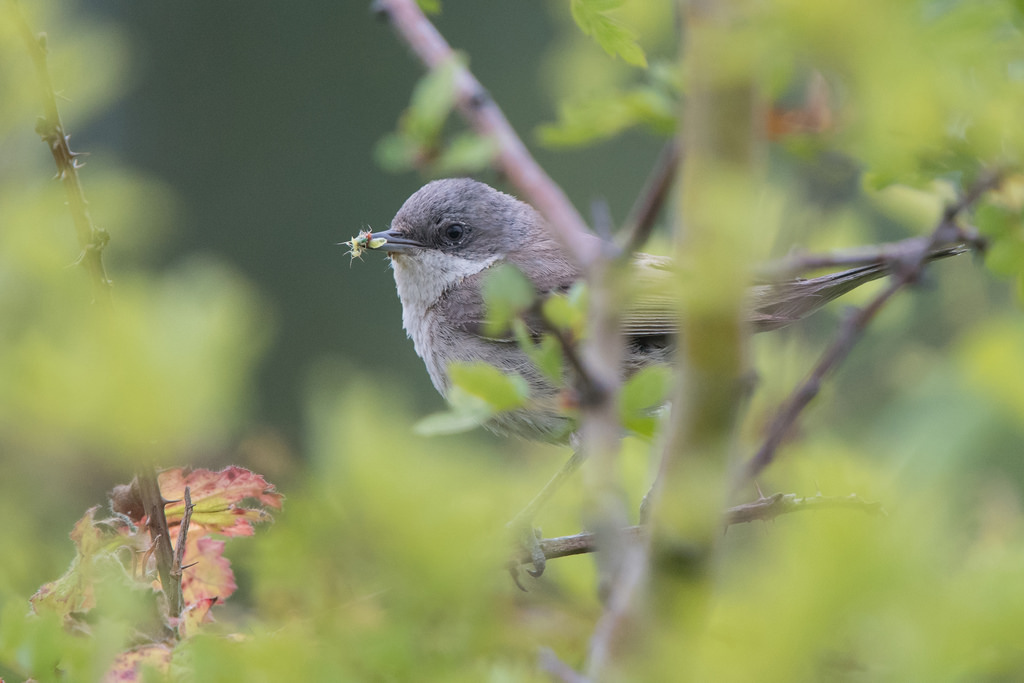
Tim writes: Not your classic full-on bird portrait but this is the kind of view you tend to get of Lesser Whitethroat. This was really difficult to capture through a tiny gap in the foliage. They usually skulk about in bushes unless you catch them singing in the spring. This one was collecting insects to feed recently fledged youngsters. Lesser Whitethroats are much less common than Whitethroat in Britain. There are around 74,000 territories of Lesser Whitethroat compared with 1.1 million Whitethroat territories. They breed throughout much of England but peter out in the hills so are less common in the Pennines, Wales, Scotland and the West Country. Most migrant birds cross the Mediterranean area trying to avoid long sea crossings, so most cross at Gibraltar or around the east side (Turkey, Lebanon, Israel) with some filtering down Italy or using Malta as a stepping stone. But Lesser Whitethroats are highly unusual in that the entire population takes the eastern route. That is a long detour for Lesser Whitethroats that breed in France and the UK.
It is a little difficult to identify this as a Lesser Whitethroat as the two best features are difficult to see. But it has dark grey legs, whereas Whitethroat’s are pinky orange. It also lacks Common Whitethroat’s bright chestnut wing panel. You can see through the foliage that the wings look plain.
Mark writes: often when I see a Lesser Whitethroat I think of the Sluice Bushes at Minsmere and an encounter with Bert Axell in about 1974 which is described on p11 of Fighting for Birds.
The images are always good and importantly to me I always find the text interesting, indeed sometimes fascinating.
Lesser whitethroats annually visit a large elderberry bush right opposite our kitchen window, usually in late August or early September. The bush also attracts blackcaps a plenty and also annually, one or two common whitethroats and garden warblers.
In addition we’ve recorded many other species taking the berries including seed predators like blue tits and bullfinches which discard the flesh and focus their attentions on the tiny seed inside.
It’s a great delight to watch the timid warblers stoking up for their flights further south.
Chiffchaffs also regularly frequent the elderberry picking up tiny insects from the leaves and twigs. So, despite the mess the birds make on my car parked close by, I would highly recommend anyone to plant an elderberry where they can watch it from inside their house.
Nick – great comment, thanks.
Agree Mark. And Blue tits sussing the value of these seeds — very interesting. A widespread tit trait or maybe not?
It is said that cattle like the shade of elders because the foliage is repellent to flies.
Elder — a common bush in need of many more Nick-like obs.
I would just add that the elder bush grew by chance in the space left by a hawthorn which died of fireblight…so it is there by luck rather than good management.
And of course because the elder is such a poor hedgerow shrub, splitting hedges open, it is never one of the species planted by farmers or other land managers.
Our bush is now dying back but at its peak, by photographing the clusters of berries and counting the berries on each and then multiplying by the (rough) number of clusters, I calculated that it had in the region of 50,000 berries!
The warblers’ visits were mostly quick and furtive – perhaps due to the threat from sparrowhawks – and mostly made early mornings. So had the bush been further away from the kitchen window I suspect most if not all of their visits would have been missed entirely.
Perhaps when reserve managers are siting hides they might consider having an elder or two in view if appropriate? The ‘season’ lasts about 6-8 weeks each year…unless wood pigeons descend on the bush. I watched one pigeon devour over 200 berries in a 10 minute session!
Nick
Another wildlife benefit of Elder is as a nest site for Willow Tits. Willow Tits are the most declined resident British bird (94% 1970-2012) and uniquely among British tits, they excavate their own nest hole. Elder wood is really soft and easy to excavate, and frequently has dead branches, and it occurs in the scrubby habitats frequented by Willow Tits. I have found more Willow Tit nests in Elder than any other species. It is a wonderful but undervalued British tree. Thanks for raising its profile.
An important point Tim…though I suppose more relevant to woodland rather than gardens.
At a woodland SSSI near here, the site is being converted back to wood pasture and this seems to involve removing much of the existing shrub layer which has much elder in it.
Now I’m sure wood pasture has some (perhaps many) benefits for biodiversity but clearly not for birds that favour an understorey like willow tits and blackcaps…..